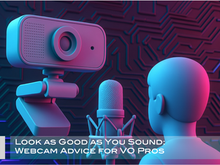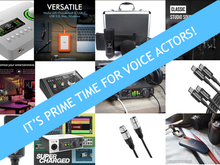5 Reasons Pro Tools Intro is a NO BRAINER for Voice Actors!
- Frank Verderosa
- Dec 29, 2023
- 6 min read
Updated: Jan 5
Everyone has their favorite DAW, and quite frankly, I don't particularly care what anyone uses at home to record their auditions or roll a backup during a directed session on Source Connect. But some of the choices do make me scratch my head, and a lot of options don't actually qualify as true DAWs in the eyes of many engineers.
Pro Tools Intro is Avid's feature-packed starter DAW that puts you in an audio post production ecosystem adopted globally by professional recording studios. As I write this, I am offering a replay class with access to a private group to master Pro Tools basics for VO. You can read about it and sign up here.
In my Source Connect and Home Studio Primer classes, I demonstrated some of what you'll see below- and I wish I had been showing people sooner, because jaws dropped!
So why would a working voice actor want to use Pro Tools Intro?
1- Pro Tools Intro is FREE
I was recently doing an evaluation session for a voice actor, and I was impressed to see that she was using Pro Tools. As we chatted, I mentioned how I wished more people would embrace Pro Tools Free as a DAW. She said "Oh- this isn't free! I'm spending like $35 a month for it!". I was curious, and asked "Oh wow- are you a musician or singer?" She said no. So I followed up with "Are you only using Pro Tools for VO auditions and sessions?" "Yes", she said. That's when I told her the FREE version of Pro Tools does everything she needs! Our little 15 minute session saved her a fortune moving forward.
Pro Tools Intro replaces Pro Tools First, which was a gateway drug to bigger versions of the DAW- much the way GarageBand is Apple's powerful but "lite" version of Logic Pro X. In the early days of Covid, I scratched Pro Tools First off my list of recommendations because it lacked the one feature voice actors needed the most: MP3 export. However, that was remedied even before it got turned into Pro Tools Intro- and it is now included.

2- Punch and Roll
A lot of folks have been sold on Adobe Audition as their weapon of choice, citing important features like "punch and roll" for audiobook narrators. I honestly don't get it- especially for the monthly cost. I can't think of anything that Audition does that Pro Tools doesn't. Audacity users also have "punch and roll", and recent improvements have made it more manageable. But it's destructive recording, meaning once you punch- everything that was there is gone.
Pro Tools offers true, non-destructive "punch and roll" recording. In addition, the ability to jump from clip to clip with key commands makes cleaning up punches a breeze. And if you goofed- no worries! You can always peel back the old or the new audio to smooth out that edit. It's all still there, because the files are always saved in an audio folder.
3- File Management

When you set up your Pro Tools session, you can choose your parameters and even store them as a template for repeated use. For example, a 24 bit 48 K WAV session with a record track, a few tracks to move things around on if you're editing, etc. Save that as a template, and spare yourself having to start from scratch each time. But more importantly, every single time you hit record- even in punch mode- that take is given a new number and saved as it's own WAV file in a folder in the destination you selected. These aren't temp files waiting to be printed. These are playable, shareable, raw WAV files. This is actually something that even GarageBand does, making it easy for audiobook narrators to gather all of their takes for a chapter and send them to their editor for easy importing and editing. Of course if you shift over to Pro Tools, you'd just share the entire session folder with the editor and they'll have everything they need.
As you can see in the image, there are four takes recorded (actually done using punch and roll), and you can clearly see that they are WAV files. At the top of this folder, you'll notice a single ".ptx" document, which is what launches that Pro Tools session and restores everything to where you left off. At home and at the studio, I'm on Pro Tools Ultimate- but I would still be able to open your session effortlessly from Pro Tools Intro!

Another important file management perk in Pro Tools is the clip window. It is a list of all of the takes and files that go into a session, and it lives in a retractable pane to the right of your edit screen. You can search for files, change how you see them (newest or oldest on top) and even choose to view auto-created files from your edits that show up under their original file. If you wanted to take 12 takes you read and drop them onto your timeline (editing window) end to end, you can choose the left to right timeline drop order, select them all and drag them over. This is super handy for audiobook or other narration work, where you can see the reads and quickly jump from take to take for speedy cleanup.

4- Session File Backups
The kinds of projects I work on for film, television and commercial clients can get pretty large- both in track count and file size. With the power of newer Macs and increased stability in Pro Tools, we encounter fewer problems than we did a decade or more ago. However, I still like to leave a trail of breadcrumbs when I work. Pro Tools allows you set save incremental backup files as you work so that if something were to happen- all is not lost! I keep mine set to backup every one minute and keep the most recent 200 files. I'll take it step further and do a "save as" and change the date for each new day I work on a job. This way I can go back to any point in time. If I crash- I'm never more than a minute behind the last save. This is really important for audiobook folks too, as you spend hours in your booth and don't want a glitch to set you back a lot of time!
5- More Professional Directed Sessions with Source Connect!

One of the features that separates the wheat from the chaff in the world of DAWs is the ability to have auxiliary tracks (aux tracks). These tracks are used by mixers to route signal inside of a DAW for any number of things. For a voice actor working at home with Source Connect, an Aux track is where your Source Connect Link plugin would live. This is the plugin that comes with Source Connect Standard and above that lets you connect your DAW to the input and output of the Source Connect app. We cover this in details in my Critical Connectivity: Source Connect and Beyond class, which digs into all sorts of session workflows. "But I thought the whole point of Source Connect is that I get to act and the engineer does everything!". Yes- this is absolutely true. However- think about sessions you've been on where you were given a line read, nailed the rehearsal- only to have the client say "That was perfect! Did we get that??" Well- some engineers are pretty good about keeping rehearsals rolling... but not always. So how slick is it for YOU to be able to say "Want me to play that back? I had my Pro Tools running the whole time!". In other cases, there may have been a dropout between you and the studio, and you can play that take back to them. These simple things will make you shine in a session. I speak from experience.
In Summation....
This list can go on forever. The power being given to your for free by Avid, in my humble opinion, makes paying for other services seem foolish. Whether you're recording auditions, running backups during sessions, recording audio books, e-learning or corporate narration- being a part of the Pro Tools ecosystem puts you on the same ballfield as every studio you will work with. And that alone is reason enough to make the change.
If you want to learn more, I highly recommend heading over to Avid and downloading it now. If you've already installed Source Connect, you're already familiar with how ILok works. This extra step is what often scares people away- but I promise you- you can do it… and it's worth it! I hope to see you in the class and private group to learn more!





























Comments